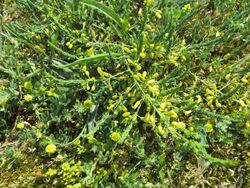Biology:Asparagus prostratus
| Wild asparagus | |
|---|---|

| |
| Scientific classification | |
| Kingdom: | Plantae |
| Clade: | Tracheophytes |
| Clade: | Angiosperms |
| Clade: | Monocots |
| Order: | Asparagales |
| Family: | Asparagaceae |
| Subfamily: | Asparagoideae |
| Genus: | Asparagus |
| Species: | A. prostratus
|
| Binomial name | |
| Asparagus prostratus K. Richt
| |
| Synonyms[1] | |
| |
Asparagus prostratus, also known as wild asparagus, is a species of flowering plant from the genus Asparagus and family Asparagaceae.
It has been placed onto the UK Biodiversity Action Plan list of priority species.[2]
Description
A. prostratus is a perennial species.[3] It has a prostrate growth habit and needle like leaves that can reach up to 2.4 cm long.[4] A. prostratus stems grow from rhizomes.[3] It produces small, yellow, bell-shaped flowers.[4] Berries start off green and begin to turn red between July and October.[4] The berries are toxic to humans and cause diarrhoea and vomiting.[5]
Reproduction
A. prostratus is a dioecious species, with plants being either male or female.[4] Colonies of this species therefore require both male and female plants for successful sexual reproduction. Plants will flower from May and June.[4] Flowers are pollinated by insects.[4] Once pollinated plants will produce berries.[4] Berries are eaten by animals such as birds, which help disperse the seeds.[4]
A. prostratus can also clone itself asexually. Stems sprout from rhizomes that spread horizontally beneath the soil, which helps the plant reproduce through vegetative reproduction.[4] This allows the species to reproduce when either male or female plants are absent.
Distribution
This species is endemic to Europe, where it has been recorded on the coastlines of: Belgium, the Channel Islands, Denmark , France , Germany , Ireland, Spain , the United Kingdom and the Netherlands.[6][7]
It is believed the species may be extinct in Germany.[4]
Habitat
A. prostratus can be found growing in coastal habitats such as cliffs, sand dunes and shingle beaches.[4]
Threats
Isolation between male and female plants on different sites prevents successful pollination and seed production.[8] This causes plants to rely on asexual vegetative reproduction, creating genetic copies of themselves. Genetic diversity is important as it helps plant species adapt to changing environments. Lowered genetic diversity puts populations at risk as they are less likely to be able to adapt to threats such as disease or climate change.[9]
The non-native plant species Carpobrotus edulis has escaped to coastal habitats where it outcompetes native species such as A. prostratus.[8] It was originally introduced into the United Kingdom as a garden plant during the 1690s. It has colonized cliffs where it has to be removed by National Trust wardens.[10]
Coastal erosion causes loss of habitat for A. prostratus. Cliff and sand dune habitats can be damaged by erosion.[11][12]
Gallery
References
- ↑ "Asparagus prostratus" (in en). Royal Botanic Gardens, Kew. http://www.plantsoftheworldonline.org/taxon/531263-1. Retrieved 22 May 2022.
- ↑ "UK Biodiversity Action Plan List of UK BAP Priority Vascular Plant Species (2007)". 2007. https://data.jncc.gov.uk/data/98fb6dab-13ae-470d-884b-7816afce42d4/UKBAP-priority-vascular-plants.pdf.
- ↑ 3.0 3.1 "Asparagus officinalis subsp. prostratus". 2022-03-21. https://www.brc.ac.uk/plantatlas/node/3263.
- ↑ 4.00 4.01 4.02 4.03 4.04 4.05 4.06 4.07 4.08 4.09 4.10 "Asparagus prostratus Dumort.". 2022-03-21. https://species.nbnatlas.org/species/NHMSYS0000456142#overview.
- ↑ "Wild Asparagus (Asparagus prostratus) Identification Guide". 2022-03-04. https://totallywilduk.co.uk/2022/03/04/wild-asparagus-asparagus-prostratus-identification-guide/.
- ↑ "Asparagus prostratus Dumort.". 2022-03-21. https://powo.science.kew.org/taxon/urn:lsid:ipni.org:names:531263-1.
- ↑ "Asparagus prostratus". 2022-03-21. https://naturalhistory.museumwales.ac.uk/corespecies/CMS/Resources/pdfs/Asparagus_prostratus/Asparagus_prostratus.pdf.
- ↑ 8.0 8.1 H., B., King, Edwards (2007). "Hand pollination of a single female wild asparagus Asparagus prostratus plant near Ferrybridge in Dorset, using pollen taken from plants in Cornwall, southwest England". https://conservationevidencejournal.com/reference/pdf/2265.
- ↑ "Why is Genetic Diversity Important?". 2016. https://www.usgs.gov/news/why-genetic-diversity-important.
- ↑ Kent, Kent, Michael, Merryn (2008). Cornwall from the Coast Path. United Kingdom: Alison Hodge. pp. 121. ISBN 9780906720684.
- ↑ "Sand dune erosion at East Head". 2022-03-22. https://www.nationaltrust.org.uk/east-head/features/sand-dune-erosion-at-east-head.
- ↑ Shadrin, Nickolai (2013). "Coupling of Shoreline Erosion and Biodiversity Loss: Examples from the Black Sea". https://www.researchgate.net/publication/256847816.
Wikidata ☰ Q21246275 entry
 |





